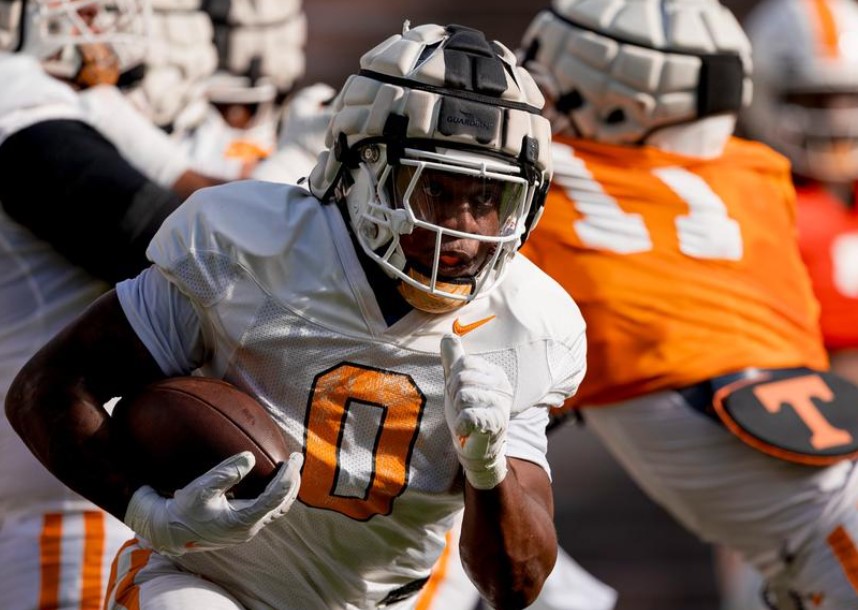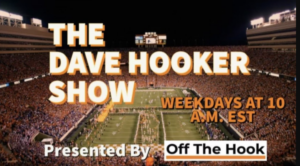Considering the current era of football, Tennessee has the perfect tailback – or, actually, three of them.
The days are gone when a team will rely on one single bell-cow running back to handle all duties: running the football, catching the football and pass protection. Tailbacks nowadays have to do all three of those duties and more. The Vols’ roster is well equipped to provide a handful of backs that can do just that.
Flashback to 2022 and Jabari Small was the talk of preseason camp. He had added 15 pounds of muscle and was ready to take on the season without any concern of being injured or even banged up. Sure enough, Small, who is now a senior, ended up with enough nicks and bruises to affect his productivity by the end of the season. The 15 pounds he gained helped, but it wasn’t enough to keep him 100-percent healthy all season. That didn’t stop the Vols. Enter Jaylen Wright.
Wright has already received praise for gaining weight and being stronger this season, just like Small did a year ago. However, the junior is now doing the little things that are getting noticed by Tennessee’s coaching staff, like working with younger players and staying engaged even when he’s not in the first-team lineup during preseason camp. Need more? Dylan Sampson had one of the best offseasons of any Vol. He’ll be a factor for Tennessee this season, no question.
Sampson is the smallest of Tennessee’s tailbacks. He’s 5-foot-11 and 190 pounds while Small and Wright are 5-11, 213 and 5-11 and 210, respectively. Sampson is clearly the quickest and fastest tailback in Tennessee’s rotation and is poised for a breakout season. Then, there’s freshman Cam Seldon. The 6-2, 222-pound tailback may have more overall athletic ability than any of Tennessee’s tailbacks and was the Vols’ most productive running back in spring camp. However, it remains to be seen if he can unseat the Vols’ top trio for significant carries. That brings us back to the top three.
Small’s 157 rushing attempts led the Vols last season as he was Tennessee’s first go-to back. However, he wasn’t the most productive Vol tailback per carry last season with just 4.7-yards per rush. Wright, who had 146 carries, averaged six-yards per carry. Sampson, who 58 carries, averaged 6.8-yards per rush. Small’s average is a bit lower because he was used in short-yardage situations often. Freshman Khalifa Keith should be able to take up some of those carries.
Wright seems to be the Vols’ best all around running back. He has speed to burn. In fact, he was known to rely too much on that speed, often bouncing plays outside instead of getting tough, physical yards in the tackle box that Tennessee’s coaches have said he’s more intent on picking up this season.
Sampson is more physical than his size and running style might indicate. However, his role will clearly be defined by plays on the perimeter, screen passes and various other ways to utilize his speed and quickness.
The Vols have a long history of having a stable of tailbacks. No one would turn down an all time SEC great like Georgia’s Herschel Walker, but the Vols have had groups of tailbacks that would rival anyone in the history of the SEC. Charlie Garner, Aaron Hayden and James Stewart come to mind in the early 1990’s. How about Reggie Cobb, Tony Thompson and Chuck Webb in the 1980’s?
While no one is confusing the Vols’ current trio with those all-time greats, there is a common theme. The Vols will enter the season with more tailbacks than they need, which will likely end up being enough tailbacks to finish the season. There won’t likely be a team in the SEC this season that doesn’t lose a tailback to injury or at least have one slowed up by physical ailments, as Small was last season.
“The running back position, just through attrition, sometimes guys get bumps and bruises,” running backs coach Jerry Mack said. “Obviously we all feel like those guys are three-down backs, so we feel like they can play every down. We don’t have to rotate guys in for short-yardage and pass-pro and things like that. All of them have grown. Right now, it’s really tough to say (who might lead the pack).
“How we’ve played here in the past, we’ve rotated, usually had a two-headed monster, and Dylan Sampson was able to get into the rotation last year and really have some great success, so it really just depends on the flow of the game. One thing about running backs, if a guy has a hot hand, you want to keep him in, so that’s no different than what we’re trying to do. If a guy is really in a rhythm, I’d be crazy to take that guy out. I’ve got to continue to get the most out of him while he’s in a rhythm. But I do foresee – we’re going to need all those guys as the season progresses.”
With the current era of football, Mack couldn’t be more correct and he also couldn’t be happier that he has at least three choices at tailback heading into the season.









One Response
Left out probably the most dynamic quartet of running backs in Vol history: ’98: Jamal Lewis, Travis Henry, Shawn Bryson, and Travis Stephens. Has there ever been a group of running backs better than that in the SEC?